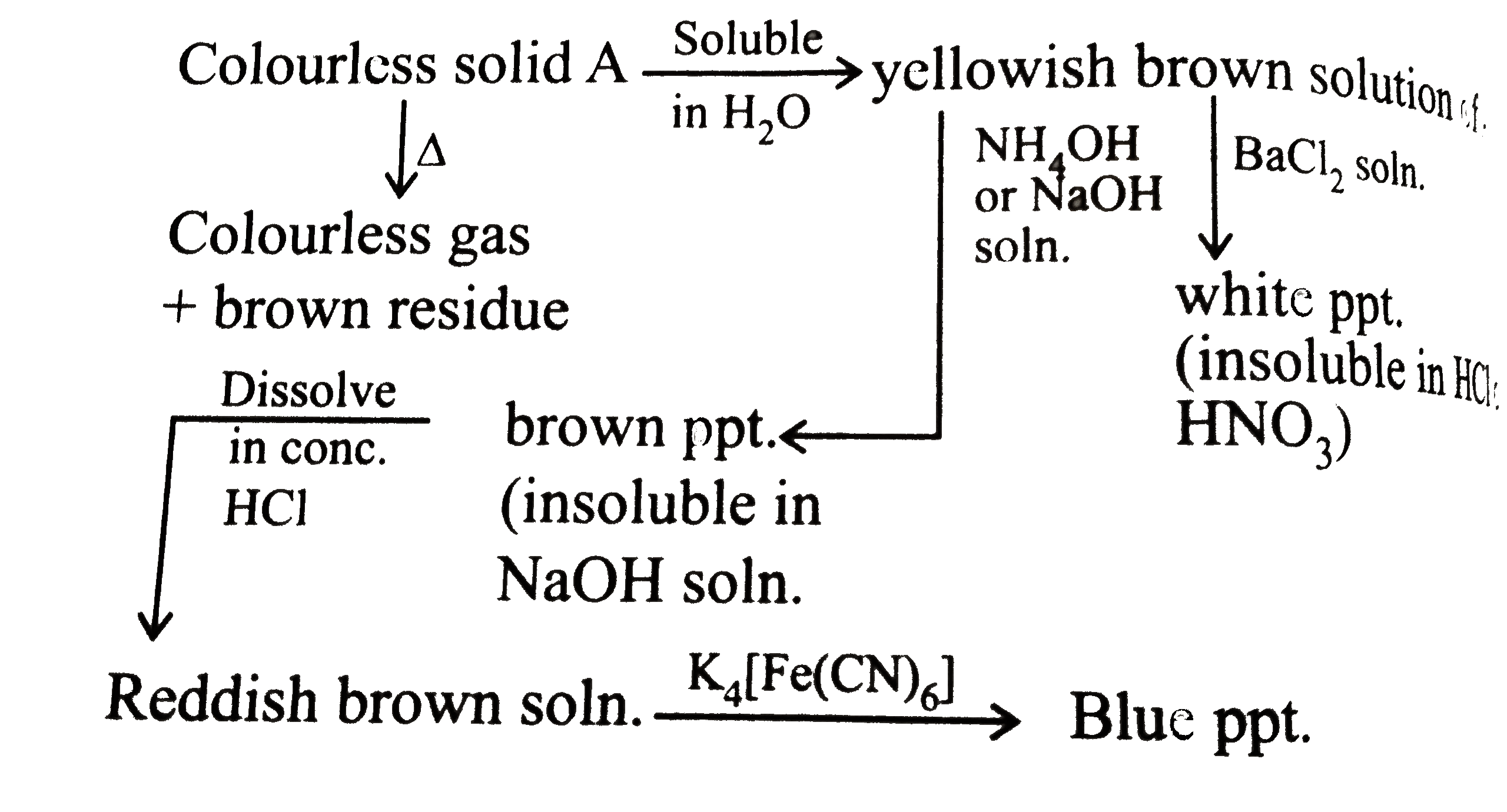All the following complexes show decrease in their weights when placed in a magnetic balance then the group of complexes having tetrahedral geometry is :
II,III,V
I,II,III
I,III,IV
none of these
The correct Answer is:D
To determine which of the given complexes have tetrahedral geometry, we will analyze each complex based on its electronic configuration, oxidation state, and hybridization.
1. Analyze Ni(CO)₄:
- Nickel (Ni) has an electronic configuration of (Ar) 3d⁸ 4s².
- In Ni(CO)₄, Ni is in the zero oxidation state (0).
- CO is a strong field ligand and leads to the pairing of electrons.
- The hybridization is sp³ (4 coordinate bonds).
- Geometry: Tetrahedral.
2. Analyze K(AgF₄):
- The oxidation state of Ag in K(AgF₄) can be calculated as follows: Let the oxidation state of Ag be x. The equation becomes x + 4(-1) = -1, leading to x = +3.
- The electronic configuration of Ag in +3 state is (Kr) 4d⁸.
- The ligands (F⁻) are strong field ligands, leading to pairing of electrons.
- The hybridization is dsp² (4 coordinate bonds).
- Geometry: Square planar.
3. Analyze Na₂(Zn(CN)₄):
- The oxidation state of Zn in Na₂(Zn(CN)₄) is +2.
- The electronic configuration of Zn in +2 state is (Ar) 3d¹⁰.
- Since the d-orbitals are fully filled, only s and p orbitals are available for hybridization.
- The hybridization is sp³ (4 coordinate bonds).
- Geometry: Tetrahedral.
4. Analyze K₂(PtCl₄):
- The oxidation state of Pt in K₂(PtCl₄) is +2.
- The electronic configuration of Pt in +2 state is (Xe) 4f¹⁴ 5d⁸.
- The ligands (Cl⁻) are strong field ligands, leading to pairing of electrons.
- The hybridization is dsp² (4 coordinate bonds).
- Geometry: Square planar.
5. Analyze (RhCl(PPh₃)₃):
- The oxidation state of Rh can be determined by considering the charge of the complex.
- Assuming Rh is in +3 oxidation state, its electronic configuration is (Kr) 4d⁶.
- The bulky ligand PPh₃ allows for tetrahedral arrangement.
- The hybridization is sp³ (4 coordinate bonds).
- Geometry: Tetrahedral.
Summary of Complexes:
- Tetrahedral Geometry: Ni(CO)₄, Na₂(Zn(CN)₄), (RhCl(PPh₃)₃)
- Square Planar Geometry: K(AgF₄), K₂(PtCl₄)
Final Answer:
The group of complexes having tetrahedral geometry is:
- Ni(CO)₄
- Na₂(Zn(CN)₄)
- (RhCl(PPh₃)₃)
- Nickel (Ni) has an electronic configuration of (Ar) 3d⁸ 4s².
- In Ni(CO)₄, Ni is in the zero oxidation state (0).
- CO is a strong field ligand and leads to the pairing of electrons.
- The hybridization is sp³ (4 coordinate bonds).
- Geometry: Tetrahedral.
- The oxidation state of Ag in K(AgF₄) can be calculated as follows: Let the oxidation state of Ag be x. The equation becomes x + 4(-1) = -1, leading to x = +3.
- The electronic configuration of Ag in +3 state is (Kr) 4d⁸.
- The ligands (F⁻) are strong field ligands, leading to pairing of electrons.
- The hybridization is dsp² (4 coordinate bonds).
- Geometry: Square planar.
- The oxidation state of Zn in Na₂(Zn(CN)₄) is +2.
- The electronic configuration of Zn in +2 state is (Ar) 3d¹⁰.
- Since the d-orbitals are fully filled, only s and p orbitals are available for hybridization.
- The hybridization is sp³ (4 coordinate bonds).
- Geometry: Tetrahedral.
- The oxidation state of Pt in K₂(PtCl₄) is +2.
- The electronic configuration of Pt in +2 state is (Xe) 4f¹⁴ 5d⁸.
- The ligands (Cl⁻) are strong field ligands, leading to pairing of electrons.
- The hybridization is dsp² (4 coordinate bonds).
- Geometry: Square planar.
- The oxidation state of Rh can be determined by considering the charge of the complex.
- Assuming Rh is in +3 oxidation state, its electronic configuration is (Kr) 4d⁶.
- The bulky ligand PPh₃ allows for tetrahedral arrangement.
- The hybridization is sp³ (4 coordinate bonds).
- Geometry: Tetrahedral.
- Tetrahedral Geometry: Ni(CO)₄, Na₂(Zn(CN)₄), (RhCl(PPh₃)₃)
- Square Planar Geometry: K(AgF₄), K₂(PtCl₄)
The group of complexes having tetrahedral geometry is:
- Ni(CO)₄
- Na₂(Zn(CN)₄)
- (RhCl(PPh₃)₃)
Topper's Solved these Questions
- COORDINATION COMPOUNDSBOOK - RESONANCE ENGLISHCHAPTER - COORDINATION COMPOUNDSEXERCISE - Exercise-2 Part-II: Single and double value integer Type
10 Videos
- COORDINATION COMPOUNDSBOOK - RESONANCE ENGLISHCHAPTER - COORDINATION COMPOUNDSEXERCISE - Exercise-2 Part-III: One of More than One Options Correct Type
12 Videos
- COORDINATION COMPOUNDSBOOK - RESONANCE ENGLISHCHAPTER - COORDINATION COMPOUNDSEXERCISE - Exercise Part-III: Match the column
2 Videos
- CHEMISTRY IN EVERYDAY LIFEBOOK - RESONANCE ENGLISHCHAPTER - CHEMISTRY IN EVERYDAY LIFEEXERCISE - ORGANIC CHEMISTRY(Chemistry in every day life)
31 Videos
- D & F BLOCK ELEMENTSBOOK - RESONANCE ENGLISHCHAPTER - D & F BLOCK ELEMENTSEXERCISE - ORGANIC CHEMISTRY(Aldehydes , Ketones, Carboxylic acid)
15 Videos
Similar Questions
Allthe following complexes show a decrease in their weights when placed in a magnetic balance. Then which of the these has square planar geometry ?
View SolutionThe correct order of the calculated spin - only magnetic moments of complexes (A) to (D) is :
(A) Ni(CO)4
(B) [Ni(H2O)6]Cl2
(C) Na2[Ni(CN)4]
(D) PdCl2(PPh3)2
View Solution
Knowledge Check
The geometry of Ni(CO)4 and Ni(PPh3)Cl2 are
Aboth square planarBtetrahedral and square planar respectivelyCboth tetrahedralDsquare planar and tetrahedral respectively.
The geometry and magnetic behaviour of the complex [Ni(CO)4] are
View SolutionK4[Fe(CN)6]+2ZnSO4→Zn2[Fe(CN)6]⏐⏐↓+2K2SO4
View SolutionThe magnetic moment of complex given below are in the order:
(I) [Ni(CO)4]
(II) [Mn(CN)6]4−
(III) [Cr(NH3)6]3+
(IV) [CoF6]3−
View SolutionThe magnetic moment of complex given below are in the order:
(I) [Ni(CO)4]
(II) [Mn(CN)6]4−
(III) [Cr(NH3)6]3+
(IV) [CoF6]3−
View SolutionThe paramagnetic and tetrahedral complexes among the following are−a−[NiCl4]2−,b−[CuCl4]2−,c−[Ni(CO)4],d−[Ni(CN)4]2−
View Solution
Which of the following complex is formed when A reacts with K4[Fe(CN)6]?
View SolutionArrange the following complexes in decreasing orger of magnetic moment:
[Ni(H2O)4]2+,[Ni(CN)4]2−,[Fe(CN)6]3−,[Fe(CN)6]4−
View Solution
